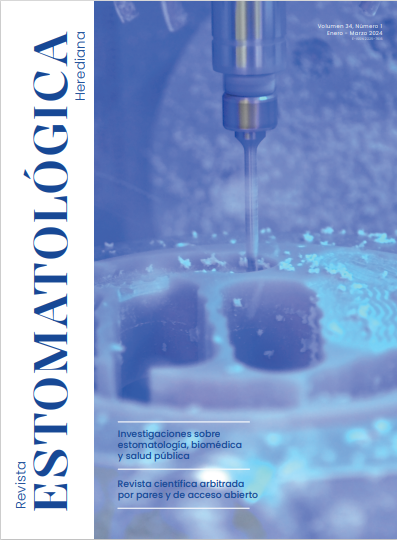Inverted classroom or master class: innovate or die
DOI:
https://doi.org/10.20453/reh.v34i1.5322Keywords:
didactic strategies, inverted classroom, dental educationAbstract
Strategies for communicating information have undergone many changes, which have been evidenced in the pandemic. The idea is to be able to connect with the student and that the information is received in a clear, timely and relevant manner, so that he/she will have the prior knowledge to integrate information from theory and practice, in order to successfully face the simulated activity, as well as when interacting with the patient. In this context, the inverted classroom is a didactic strategy that provides videos, podcasts, among others, to be reviewed in advance, so that when the student performs the face-to-face or virtual activity, the most important concepts are deepened and clarified, using active participation methodologies to achieve the following objective: Invested learning seeks a change in the dynamics of learning that points to the student as its axis. The objective of this teaching contribution is to share the benefits of this strategy used with students of the Dentistry degree program within the framework of the Adult Stomatology Clinic I course, taught in 2023 and which belongs to the fifth semester of the Stomatology degree program at the Universidad Peruana Cayetano Heredia.
Downloads
References
Saravia-Rojas MÁ. Aula invertida utilizada en la enseñanza de la estomatología: una aproximación. Rev Estomatol Herediana [Internet]. 2023; 33(2): 176-181. Disponible en: https://doi.org/10.20453/reh.v33i2.4516
Carvalho H, McCandless M. Implementing the flipped classroom. Rev HUPE [Internet]. 2014; 13(4): 39-45. Disponible en: https://doi.org/10.12957/rhupe.2014.13946
Binnie RSL, Bonsor SJ. The implementation of a flipped classroom approach at a UK dental school. Br Dent J [Internet]. 2021; 231(7): 405-408. Disponible en: https://www.nature.com/articles/s41415-021-3125-6
Varela Kellesarian S. Flipping the Dental Anatomy Classroom. Dent J [Internet]. 2018; 6(3): 23. Disponible en: https://doi.org/10.3390/dj6030023
Faraone KL, Garrett PH, Romberg E. A blended learning approach to teaching pre-clinical complete denture prosthodontics. Eur J Dent Educ [Internet]. 2013; 17(1): e22-e27. Disponible en: https://doi.org/10.1111/j.1600-0579.2012.00753.x
Carvalho H, West CA. Voluntary participation in an active learning exercise leads to a better understanding of physiology. Adv Physiol Educ [Internet]. 2011; 35(1): 53-58. Disponible en: https://doi.org/10.1152/advan.00011.2010
Saravia M, Orejuela F, Fukuhara M. Valoración del podcasting en la enseñanza clínica en el área de odontología restauradora. Rev Estomatol Herediana [Internet]. 2020; 30(2): 108-112. Disponible en: https://doi.org/10.20453/reh.v30i2.3762
Inamochi Y, Kohno EY, Wada J, Murakami N, Takaichi A, Arai Y, et al. Knowledge acquisition efficacy of a remote flipped classroom on learning about removable partial dentures. J Prosthodont Res [Internet]. 2023; 67(3): 444-449. Disponible en: https://doi.org/10.2186/jpr.jpr_d_22_00147
Eachempati P, Kumar KSK, Ismail ARH. The flipped classroom in dental education-learning beyond the four walls of the classroom. MedEdPublish [Internet]. 2018; 7: 42. Disponible en: https://mededpublish.org/articles/7-42
Wang Z, Kohno EY, Fueki K, Ueno T, Inamochi Y, Takada K, et al. Multilevel factor analysis of flipped classroom in dental education: a 3-year randomized controlled trial. PLoS One [Internet]. 2021; 16(9): e0257208. Disponible en: https://doi.org/10.1371/journal.pone.0257208
Kohli S, Sukumar AK, Zhen CT, Yew ASL, Gomez AA. Dental education: Lecture versus flipped and spaced learning. Dent Res J (Isfahan) [Internet]. 2019; 16(5): 289-297. Disponible en: https://www.ncbi.nlm.nih.gov/pmc/articles/PMC6749854/
Sivarajan S, Soh EX, Zakaria NN, Kamarudin Y, Lau MN, Bahar AD, et al. The effect of live demonstration and flipped classroom with continuous formative assessment on dental students' orthodontic wire-bending performance. BMC Med Educ [Internet]. 2021; 21(1): 326. Disponible en: https://doi.org/10.1186/s12909-021-02717-5
Downloads
Published
How to Cite
Issue
Section
License
Copyright (c) 2024 Miguel Á. Saravia-Rojas, Elizabeth Casas-Chavez

This work is licensed under a Creative Commons Attribution 4.0 International License.
The authors retain the copyright and cede to the journal the right of first publication, with the work registered with the Creative Commons License, which allows third parties to use what is published as long as they mention the authorship of the work, and to the first publication in this journal.























